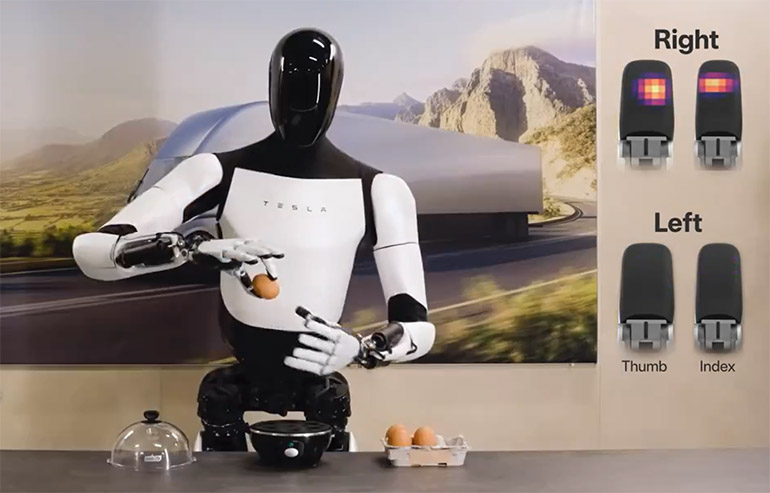|
Listen to this article  |

Optimus Gen 2 demonstrates sense of touch and dexterity. Source: Tesla
Tesla today showed that its Optimus humanoid robot has new levels of humanlike dexterity and mobility. In a post to X (formerly Twitter), the Austin, Texas-based company briefly showed Optimus handling eggs from a carton.
The latest version of the robot has hands with 11 degrees of freedom (DoF) and tactile sensors in each finger.
The video outlines its progress from Bumblebee in September 2022 to Optimus Gen 1 in March 2023 and Gen 2 this month.
There’s a new bot in town 🤖
Check this out (until the very end)! https://t.co/duFdhwNe3K pic.twitter.com/8pbhwW0WNc
— Tesla Optimus (@Tesla_Optimus) December 13, 2023
Tesla touted features including actuators and sensors designed in-house, a 2-DoF neck, and integrated electronics and harnessing for its actuators.
The company also briefly listed improvements including a 30% boost in walking speed, force/torque sensing and articulated toe sections in its feet, as well as “human foot geometry.” This is in contrast to the digitigrade legs and feet of some robots.
In addition, Tesla said it has reduced the total weight of its humanoid by 10 kg (22 lb.), which is important for energy consumption, cost, and safety. The company claimed that the robot has improved balance, showing squat thrusts.
Tesla has said it will initially use Optimus in its automotive and battery factories, with plans to replace scarce human labor in other applications further in the future.
At RoboBusiness in October, experts from . Jeff Cardenas, co-founder and CEO of Apptronik; Jonathan Hurst, co-founder and chief robot officer of Agility Robotics; and Geordie Rose, co-founder and CEO of Sanctuary, discussed the state of humanoid robotics.
Tesla issues recall because of Autopilot concerns
Not all of Tesla’s news today was positive. The company is recalling more than 2 million vehicles as the National Highway Traffic Safety Administration (NHTSA) continues to investigate safety problems around its Autopilot system.
When Tesla first announced the feature, some drivers recorded themselves with their hands off the steering wheel, and critics have asserted that the company didn’t clearly state the risks of relying too heavily on Autopilot.
In February, Tesla issued a voluntary recall of 363,000 Model S, Model 3, Model X and Model Y vehicles.
The NHTSA has reviewed 956 crashes in which Autopilot was allegedly in use, reported The Wall Street Journal. The agency expressed concern about the software and its use rather than Tesla’s reliance on vision over lidar.
The recall came just weeks after CEO Kyle Vogt left Cruise and General Motors made significant layoffs. The moves raised doubts about the health of self-driving industry. In October, California suspended Cruise’s permit to operate autonomous robotaxis in the state in response to safety incidents.
Waymo, arguably a leading developer in the space, dropped the “self-driving” term in 2021. Similarly, Toyota Research Institute has said its Human Interactive Driving Division is focused on keeping humans “in the loop” with AI-assisted driving.
Credit: Source link


Comments are closed.